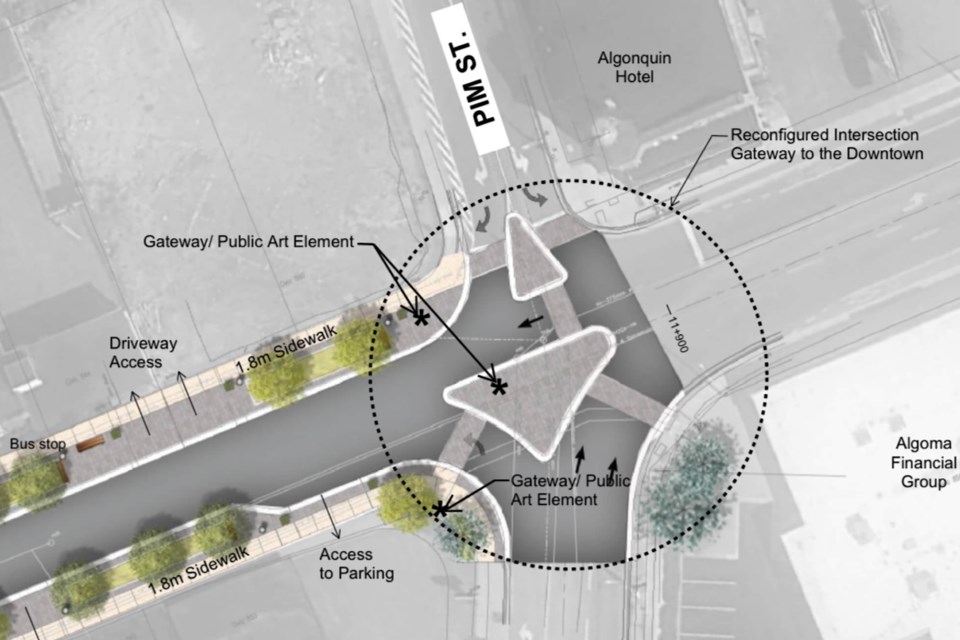Sault Trails Advocacy Committee has emerged as a last-minute opponent to details of an $18-million proposed reconstruction of Queen Street.
As SooToday reported last week, city council will be asked tonight to approve rebuilding our main drag downtown with two one-way lanes of westbound traffic and lane widths reduced from 3.55 metres to 3.3 metres.
"The easiest way to make Queen Street more accessible and safe is eliminating all traffic lights and replacing them with four‐way stop signs," the trails group says in a letter delivered to the city today.
"Similarly, removing turning lanes and including mid‐block crosswalks could add additional space for other street users and improve their downtown experience.
"To make the downtown as safe as possible for cyclists, a two‐way segregated path would be best. This could virtually eliminate the problem of cyclists using sidewalks and creating a risk for all street users."
"Above all, we believe that one lane of vehicular traffic can easily handle existing volumes on Queen Street."
City councillors are expected to decide the issue at a meeting starting at 5 p.m. tonight, livestreamed on SooToday.
The following is the full text of the letter received by city officials today:
Comments from STAC
Dear Mayor Shoemaker, members of city council and planning department.
We appreciate the depth of the council report and the willingness to pilot options in design using current best practice.
We share the city's vision of a downtown that is an exciting and vibrant destination; safe and welcoming to everyone in the community and attractive to visitors.
Further, the city has repeatedly recognized that we face an unprecedented climate crisis that requires policymakers of all levels and stripes to make meaningful changes.
Luckily for our city and for us as residents, we’ve already made significant investments in active transportation.
Building upon this momentum should include making the heart of our downtown as accessible, inclusive and safe as possible for those who bike, walk, use public transportation, or have limited mobility.
Perhaps the easiest way to make Queen Street more accessible and safe is eliminating all traffic lights and replacing them with four‐way stop signs.
This would drastically reduce speeding and its negative impact on safety and drastically improve the downtown experience for pedestrians, who would have an automatic right of way.
Similarly, removing turning lanes and including mid‐block crosswalks could add additional space for other street users and improve their downtown experience.
To make the downtown as safe as possible for cyclists, a two‐way segregated path would be best. This could virtually eliminate the problem of cyclists using sidewalks and creating a risk for all street users.
Although concerns have been raised about the clearing of snow and bus stops on Queen Street with such infrastructure in place, there is ample time and space to find a creative plan that satisfies the needs of all street users and conserves finite city resources.
It may also be possible to reduce (or even remove) most of the parking on one side of Queen Street (the one adjacent to two‐way cyclists and pedestrians).
Based on current statistics, our downtown core has an overabundance of parking spots, with around 10,000 spots that cover almost 40 per cent of available land.
According to one urban planning resource ‐ Parking Reform Network ‐ our community has one of the highest percentages of its downtown dedicated solely to parking in all of North America.
Therefore, we suggest the city continues to examine the issue as a part of its broader downtown revitalization strategy and especially borrow best practices from other communities that have developed more efficient management systems for downtown parking.
Above all, we believe that one lane of vehicular traffic can easily handle existing volumes on Queen Street.
Based on the current design, Queen Street can be an overwhelming experience for other street users, routinely seeing aggressive driving, speeding, and a commensurate decrease in overall accessibility and safety.
Thankfully, the city has been receptive and responsive to community input. Therefore, we would like to offer some of these suggestions as an invitation to consideration.
Perhaps engaging additional experts in design would be beneficial in order to get this element of downtown planning right.
Considering the importance of Queen Street to our downtown and our entire community, we see this as an element of local planning that requires as much attention and care as possible.
An accessible, rejuvenated, and vibrant downtown can also have derivative effects that satisfy pressing policy problems, like crime prevention through community presence, more active lifestyles and community health, potential incentives for dense housing developments, and a positive economic environment for downtown merchants.
We thank you for your consideration.
STAC – Sault Trails Advocacy Committee
